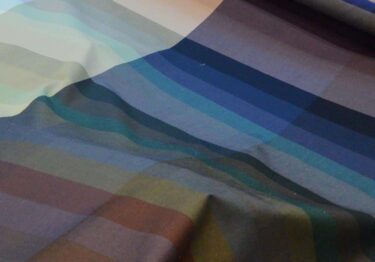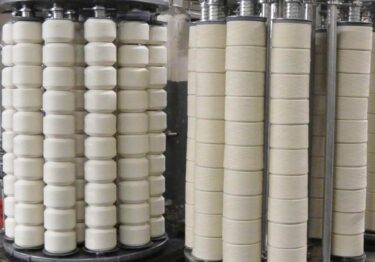
I meet so many people who ask me if there are any ‘chemicals’ on my fabrics. I find it hard to greet this question without feeling incredulous. Our science literacy, within the fashion community, is patchy and widely variable, as a result we can get our knickers in a knot about some things and be completely oblivious to others. Water, salt, tannins in gum leaves, snake venom, sap, olive oil etc. are all chemicals and compounds of chemicals. So are benzene, chromium salts, penicillin, petrol, I think you get my drift! The question I think people are really asking is ‘are there any harmful residual chemicals on this product, or used in its journey to get here?’
Invariably the answer is ’no’ to harmful residual chemicals but ’sometimes’ for during processing stages, but so much of that depends on concentrations, or temporary stages of processing, and it’s the safe handling and management of chemicals, that can cause harm if discharged poorly, that’s really the mark of good processing. Think about it, salt water is safe to swim in, small quantities can be used as an antiseptic but drinking large volumes would eventually be toxic.
Our industrial textile world has seen a lot of changes over the last 200 years, yes mills in Europe could be hideous, and yes rivers were dead. Today, there are polluted rivers in countries newer to textile and other manufacturing industries, but those rivers in Europe, their bio diversity has returned, and yes, the textile industry is still there. So what happened?
Here’s where we meet the Good Wizards. I surprise people when I tell them that dye chemistry has changed in the last 50 years, ‘Oh that’s really good to know,’ I hear. There’s no need for nasty heavy metals, there’s no need for water in the proportions it used to be used. The ability to get batches right first time, thanks to high tech quality systems has made an inordinate difference to reduce energy use. There are chemists, physicists and engineers whose life’s work has been in research to make this industry tread as lightly as possible, people whose minds work in ways I can’t begin to pretend to keep up with, thinking in molecules and thermodynamics, algorithms and sensor systems, and while doing that creating dyes, pigments, chemicals and processes that can create textiles that last for years without fading or degrading.

However, to apply all this we need high quality supply chains using this knowledge.
Today there are dye houses where there is no effluent discharge into environmental systems other than clean water, maybe even cleaner than when it went in. Today there are dye houses with right first time at more than 95%. When best practice happens on a big scale, we make big progress. These mills aren’t the ones that make it into the fashion and clothing industry news stories and documentaries, as they are the good news.
When I set up Full Circle Fibres, it was with the idea of putting a quality supply chain together, not just to manage the integrity of provenance from the paddock, avoiding exploitation and pollution, but also to apply best practice in all the stages afterwards.
For this I have to thank the concept of ‘Standing upon the Shoulders of Giants’ (Isaac Newton 1643-1727). So many of us these days, ‘have a go,’ learn from YouTube, just muddle through. This applies to many in their early stages of starting in the fashion industry, some of us even do this with natural and synthetic dyes as we apply our creativity at home, and there’s no doubt that getting started is a big part of making progress, but I write this to encourage us all to stop and think about educating ourselves and caring about the science and the detail, and if you get the chance, or you work for a label or company big enough to be sending you out to visit suppliers’ mills, take a close look, and just think about how absolutely incredible it is that millions of metres of well managed fabrics come out ‘level,’ – not patchy – and they don’t lose colour or shape either!
Good factories are a place of wonder. So, I’d like to acknowledge those who’ve made this industry their life’s work, and every year within the relatively small global community of Industrial Textile Dyers and Colourists there are people awarded for decades of dedication and passion, and obituaries of those who’ve left a legacy of research and education that may well have benefitted people in every textile processing nation, but their names aren’t brands on the front of magazines, or noted social media ‘influencers’ impacting millions.
I studied Textile Science in the mid 1990s and have been working in this industry ever since, and when I meet people in design and fashion they often think I know so much, yet I feel like I barely scratch the surface in comparison to these good wizards!
While researching for this post I found out that there are some online tools available to you all, including free short courses, to find out more about working with colour in textiles, here : colour.network
Many many of the industries that exist to supply our daily needs are full of these people you will never have heard of, designing new medical widgets, metal salts for the batteries in your phone to last longer, efficiently making toilet paper, filtering our waste, improving solar panels, the bar code laser at the checkout, engineering more efficiency into our vehicles or L.E.D. lightbulbs and so on. Look around you, every manmade thing and tool you touch and use someone somewhere designed and produced, both it and all the systems to make it from its animal, vegetable or mineral origins.
If you are reading this, and at a stage in your life choosing study pathways, to work in sustainability and fashion, consider picking the hardest science and maths you can handle (even if you won’t get an A), choose history to learn from other’s mistakes, choose geography to learn how we are all connected (business studies can come later!), choose design as the colour and product not only has to be safe and sustainable, but to put all this hard work into items people will love and cherish.
I wrote this blog as a contribution to Not Just A Label It’s a great privilege to share my experience on such an international platform. I also sincerely thank Dr. Andrew Filarowski from the Society of Dyers and Colourists for being a wonderful sounding board!
Founder, Full Circle Fibres
| Powered by WordPress | Theme by TheBootstrapThemes